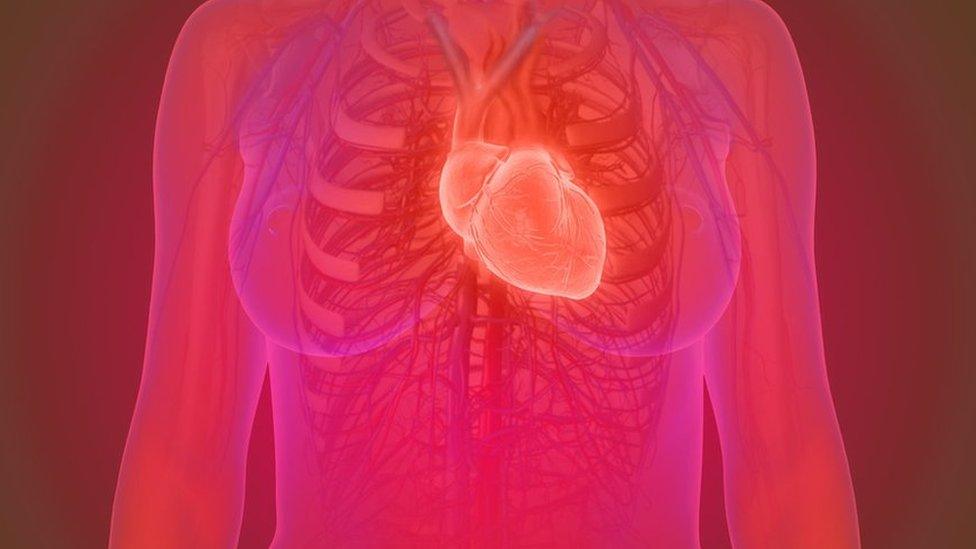Biomarkers identified to help diagnose heart condition
- Published

Researchers have identified two biomarkers that could help in the diagnosis of a heart condition that raises the risk of stroke.
Atrial fibrillation (AF) is the most common heart rhythm disturbance, affecting around 1.6m people in the UK.
But it is often only detected after someone has had a stroke.
The British Heart Foundation said the study could pave the way towards better detection of people with AF and targeted treatment.
At the moment, an electrocardiogram (ECG) which measures the electrical activity of your heart, is usually used to screen patients for atrial fibrillation.
This study, by researchers at the University of Birmingham, found that three clinical risk factors and two biomarkers had a strong connection with AF.
Those most at risk of the condition were older, male and had a high BMI.
The researchers looked at 638 hospital patients who were recruited between 2014 and 2016 for acute illnesses.
They took blood samples and looked for 40 cardiovascular biomarkers and considered seven clinical risk factors - age, sex, hypertension, heart failure, history of stroke or transient ischaemic attack, kidney function and body mass index (BMI).
They were also all given an echocardiogram.
Two biomarkers stood out as a link to atrial fibrillation, the researchers found.
One is a hormone secreted by the heart called brain natriuretic peptide (BNP) and the other is a protein responsible for phosphate regulation called fibroblast growth factor-23 (FGF-23).

The researchers say these people could be screened for the condition by testing their blood to see if they have elevated levels of the two biomarkers.
Lead author Yanish Purmah said: "The biomarkers we have identified have the potential to be used in a blood test in community settings such as in GP practices to simplify patient selection for ECG screening."
Joint first author Dr Winnie Chua said: "People with atrial fibrillation are much more likely to develop blood clots and suffer from strokes. To avoid strokes it is important for them to take anticoagulant drugs to prevent blood clotting. However, atrial fibrillation is often only diagnosed after a patient has suffered a stroke.
"Therefore it is important that patients at risk are screened so that they can begin taking anticoagulants to prevent potentially life-threatening complications."

Atrial fibrillation symptoms
Noticeable heart palpitations, when the heart feels like it is pounding, fluttering or beating irregularly
Your heart may also beat very fast (often considerably higher than 100 beats per minute)
You can work out your heart rate, external by checking the pulse in your neck or wrist.
Other symptoms may include tiredness and being less able to exercise, breathlessness, feeling faint or lightheaded and chest pain
The way the heart beats in atrial fibrillation reduces the heart's performance and efficiency
This can lead to low blood pressure (hypotension) and heart failure
You should see your GP immediately if you notice a sudden change in your heartbeat and experience chest pain
Sometimes atrial fibrillation does not cause any symptoms and a person who has it is completely unaware that their heart rate is irregular.
Source: NHS England

Professor Metin Avkiran, associate medical director at the British Heart Foundation, welcomed the study.
"Atrial fibrillation increases the risk of stroke, a serious condition that causes over 36,000 deaths in the UK each year, but is often detected too late. This research has used sophisticated statistical and machine learning methods to analyse patient data and provides encouraging evidence that a combination of easy-to-measure indices may be used to predict atrial fibrillation.
"The study may pave the way towards better detection of people with AF and their targeted treatment with blood-thinning medicines for the prevention of stroke and its devastating consequences."
The research was carried out by scientists from the Institute of Cardiovascular Sciences and the Institute of Cancer and Genomic Sciences at the University of Birmingham's College of Medical and Dental Sciences and is published in the European Heart Journal., external
- Published4 September 2018

- Published20 January 2016
